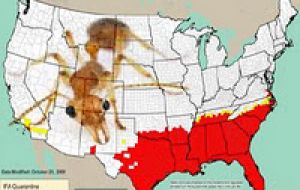MercoPress. South Atlantic News Agency
Biting ants invade by the millions Florida, Mississippi, Texas and Louisiana
 The so far indomitable hairy crazy ants
The so far indomitable hairy crazy ants It sounds like a horror movie: Biting ants invade by the millions. A camper's metal walls bulge from the pressure of ants nesting behind them. A circle of poison stops them for only a day, and then a fresh horde shows up, bringing babies. Stand in the yard, and in seconds ants cover your shoes.
It's an extreme example of what can happen when the ants -- which also can disable huge industrial plants -- go unchecked. Controlling them can cost thousands of dollars. But the story is real, told by someone who's been studying ants for a decade.
“Months later, I could close my eyes and see them moving,” said Joe MacGown, who curates the ant, mosquito and scarab collections at the Mississippi State Entomological Museum at Mississippi State University.
He's been back to check on the hairy crazy ants. They're still around. The occupant isn't.
The flea-sized critters are called crazy because each forager scrambles randomly at a speed that your average picnic ant, marching one by one, reaches only in video fast-forward. They're called hairy because of fuzz that, to the naked eye, makes their abdomens look less glossy than those of their slower, bigger cousins.
And they're on the move in Florida, Texas, Mississippi and Louisiana. In Texas, they've invaded homes and industrial complexes, urban areas and rural areas. They travel in cargo containers, hay bales, potted plants, motorcycles and moving vans. They overwhelm beehives -- one Texas beekeeper was losing 100 a year in 2009. They short out industrial equipment.
If one gets electrocuted, its death releases a chemical cue to attack to the colony, said Roger Gold, an entomology professor at Texas A&M.
“The other ants rush in. Before long, you have a ball of ants,” he said.
The ants don't dig out anthills and prefer to nest in sheltered, moist spots. In MacGown's extreme example in Waveland, Miss., the house was out in woods with many fallen trees and piles of debris. They will eat just about anything -- plant or animal.
The ants are probably native to South America, MacGown said. But they were recorded in the Caribbean by the late 19th century, said Jeff Keularts, an extension associate professor at the University of the Virgin Islands. That's how they got the nickname “Caribbean crazy ants.” They've also become known as Rasberry crazy ants, after the exterminator.
Now they're making their way through parts of the Southeast. Florida had the ants in about five counties in 2000 but today is up to 20, MacGown said. Nine years after first being spotted in Texas, that state now has them in 18 counties. So far, they have been found in two counties in Mississippi and at least one Louisiana parish.
Texas has temporarily approved two chemicals in its effort to control the ants, and other states are looking at ways to curb their spread.




Top Comments
Disclaimer & comment rules-

-

Read all commentsLooks like the ant are colonising the United States,
Oct 24th, 2011 - 03:47 pm 0Getting more advanced than humans
The ant empire of the future,
Canada next, Alaska,
The smaller species are turning against us, the end of mankind perhaps,
Or just an over reaction.
Just a creeping thought .
PHASE IV turns real.
Oct 26th, 2011 - 12:17 pm 0Come back from the grave Nigel Davenport, the Southern States needs you NOW.
It's enough to give one the TREMORS - cue Kevin Bacon to the rescue.
Commenting for this story is now closed.
If you have a Facebook account, become a fan and comment on our Facebook Page!